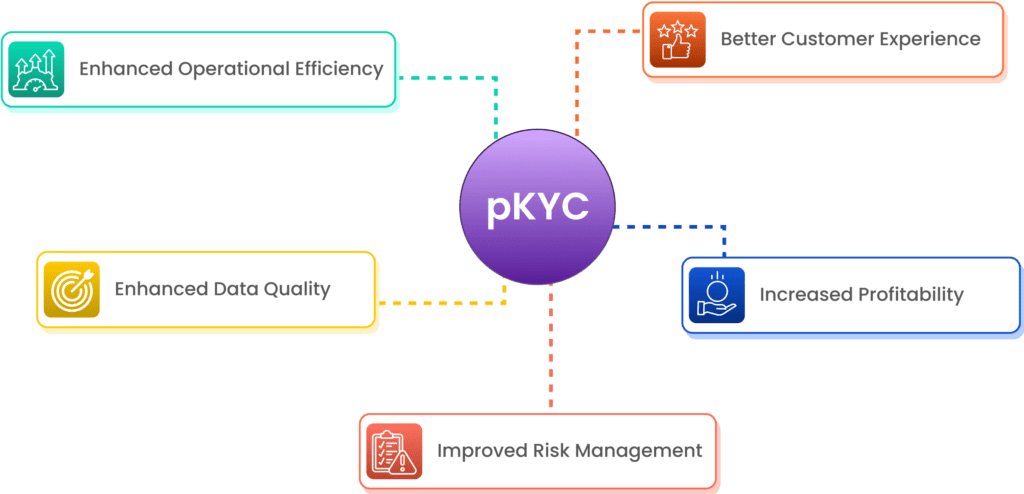Know Your Customer (KYC) is a fundamental process, which helps financial institutions verify the identities of their customers, ensuring they are who they claim to be. This process is crucial for preventing fraud, money laundering, and other financial crimes.
Traditionally, KYC has been done periodically, meaning customer information is reviewed and updated at regular intervals, such as every year or every few years. However, there’s a more advanced approach gaining popularity called Perpetual KYC (pKYC).
Understanding Perpetual KYC (pKYC)
Perpetual KYC, also known as continuous or dynamic KYC, is an approach where customer information is monitored and updated in real-time.
Unlike traditional KYC, which updates customer information periodically, pKYC ensures that the data is always current. This continuous updating helps financial institutions quickly detect and respond to changes in a customer’s risk profile.
Why is pKYC Important?
With the rise of digital banking and increasing regulatory requirements, financial institutions need to be more vigilant than ever. pKYC offers a way to meet these challenges by:
- Enhancing Risk Management: Real-time updates allow institutions to identify and mitigate risks as they arise, rather than waiting for the next scheduled review.
- Improving Efficiency: Automated updates reduce the need for manual reviews, freeing up resources for more strategic tasks.
- Boosting Customer Experience: Customers benefit from a smoother, more seamless experience without frequent requests for updated information.
The Evolution of KYC
To understand the significance of pKYC, it’s helpful to look at the traditional KYC process and its limitations.
Traditional Periodic KYC
In the traditional model, financial institutions conduct KYC reviews at fixed intervals. During these reviews, they collect and verify customer information, such as identification documents, addresses, and financial histories. This approach has several drawbacks:
- Outdated Information: Customer information can become outdated between reviews, leading to increased risk.
- Manual Processes: Periodic reviews often involve manual data collection and verification, which can be time-consuming and error-prone.
- Increased Risk Exposure: Gaps between reviews can allow suspicious activities to go undetected.
The Shift to Perpetual KYC
Perpetual KYC addresses these issues by leveraging advanced technologies like artificial intelligence (AI), machine learning, and data analytics. These technologies enable continuous monitoring and real-time updates of customer information, providing a more accurate and timely risk assessment.
Difference Between Perpetual KYC and Traditional KYC
| Feature | Traditional KYC | Perpetual KYC (pKYC) |
| Frequency | Conducted periodically (e.g., during onboarding or at set intervals) | Continuous and real-time monitoring |
| Updates | Updated manually at scheduled intervals | Automated updates based on real-time data |
| Risk Detection | Identifies risks only at the time of review | Detects risks dynamically as they occur |
| Compliance | May result in outdated information between updates | Ensures ongoing compliance with regulatory changes |
| Automation | Largely manual, requiring human intervention | Uses AI, machine learning, and automation for efficiency |
| Fraud Prevention | Higher risk due to gaps between reviews | Lower risk as anomalies are detected instantly |
| Customer Experience | Periodic re-verification may cause delays | Seamless, with minimal customer intervention |
Benefits of Perpetual KYC
Implementing pKYC offers several advantages over traditional KYC methods:
Improved Risk Management
With continuous monitoring, financial institutions can detect changes in a customer’s behavior or risk profile immediately. This proactive approach helps prevent financial crimes such as money laundering and fraud, ensuring compliance with regulatory standards.
Enhanced Operational Efficiency
Automating the KYC process reduces the need for manual intervention. Compliance teams can focus on more complex tasks, such as investigating high-risk activities, rather than routine data updates. This shift can lead to significant time and cost savings.
Better Customer Experience
pKYC minimizes the need for customers to repeatedly submit documents and information. This seamless experience can enhance customer satisfaction and loyalty, as clients enjoy quicker and more efficient service.
Increased Profitability
By reducing the frequency and cost of manual KYC reviews, financial institutions can lower operational expenses. The efficiency gains from pKYC can translate into increased profitability, allowing institutions to allocate resources more effectively.
Enhanced Data Quality
Continuous updates ensure that customer information is always current and accurate. This high-quality data can provide valuable insights into customer behavior and trends, helping institutions make more informed decisions.

Challenges of Implementing Perpetual KYC
While pKYC offers numerous benefits, its implementation can pose several challenges:
Data Privacy and Security
Continuous access to customer information raises concerns about data privacy and security. Financial institutions must implement robust security measures to protect sensitive data and comply with data protection regulations.
Integration with Existing Systems
Implementing pKYC may require significant changes to existing systems and processes. Financial institutions must carefully plan and manage the integration to ensure a seamless transition without disrupting operations.
Regulatory Compliance
As regulations evolve, institutions must ensure that their pKYC processes remain compliant. This requires ongoing monitoring of regulatory changes and updating systems and processes as needed.
How to Implement Perpetual KYC (pKYC) Effectively
To successfully implement pKYC, financial institutions should consider the following best practices:
Develop a Comprehensive Strategy
A clear strategy is essential for successful implementation. Institutions should outline their objectives, scope, and timeline for the pKYC project, ensuring alignment with business goals.
Collaborate with Stakeholders
Engage stakeholders from compliance, IT, and business teams to ensure a coordinated approach. Collaboration is key to addressing the various aspects of pKYC implementation.
Leverage Advanced Technologies
Utilize AI, machine learning, and data analytics to automate and enhance the pKYC process. These technologies can improve efficiency and accuracy, reducing the burden on compliance teams.
Monitor Regulatory Changes
Stay up-to-date with evolving regulations to ensure ongoing compliance. Institutions should regularly review and update their pKYC processes in response to regulatory developments.
Measure and Optimize Results
Continuously monitor the effectiveness of pKYC processes and make adjustments as needed. Regular assessment and optimization can help institutions achieve better outcomes and maximize the benefits of pKYC.
pKYC in India
In India, the adoption of pKYC is gaining momentum as financial institutions recognize the need for continuous compliance and risk management. The Reserve Bank of India (RBI) has been encouraging the use of digital technologies for KYC processes, making pKYC a viable option for many institutions. By adopting pKYC, Indian financial institutions and fintechs can improve their compliance with regulations, enhance customer satisfaction, and reduce operational costs.
Conclusion
Perpetual KYC represents a significant advancement in the way financial institutions manage customer due diligence. By shifting from periodic to continuous monitoring, pKYC offers improved risk management, enhanced operational efficiency, and a better customer experience. However, successful implementation requires careful planning, collaboration, and the use of advanced technologies.
As financial institutions navigate an increasingly complex regulatory landscape, adopting pKYC can help them stay compliant, reduce risks, and provide superior service to their customers.
To learn more about how Deepvue’s KYC-B/AML Soulions can enhance your KYC process, visit Deepvue.tech and explore their range of solutions designed to ensure accuracy and efficiency.
FAQs
What is the main difference between Perpetual KYC (pKYC) and traditional KYC?
The primary difference between Perpetual KYC (pKYC) and traditional KYC is the frequency and timing of updates. Traditional KYC involves periodic reviews of customer information at fixed intervals, whereas pKYC continuously monitors and updates customer information in real-time. This ensures that the data is always current and accurate, allowing for quicker identification and response to changes in a customer’s risk profile.
How does Perpetual KYC (pKYC) improve risk management for financial institutions?
Perpetual KYC (pKYC) enhances risk management by providing continuous monitoring and real-time updates of customer information. This allows financial institutions to promptly detect and respond to any changes in a customer’s behavior or risk profile.
By identifying potential risks as they arise, institutions can take proactive measures to prevent financial crimes such as money laundering and fraud.
What technologies are used to implement Perpetual KYC (pKYC)?
Perpetual KYC (pKYC) leverages advanced technologies such as artificial intelligence (AI), machine learning, event based trigger and data analytics. These technologies enable automated data collection, real-time monitoring, and continuous updates of customer information. AI and machine learning help in detecting unusual patterns and potential risks, while big data analytics provide valuable insights into customer behavior.
What are the challenges of implementing Perpetual KYC (pKYC)?
Implementing Perpetual KYC (pKYC) can pose several challenges, including:
Regulatory Compliance: Institutions must continuously monitor and update their pKYC processes to comply with evolving regulations.
Data Privacy and Security: Continuous access to customer information requires robust security measures to protect sensitive data and ensure compliance with data protection regulations.
Integration with Existing Systems: Significant changes to existing systems and processes may be needed, requiring careful planning and management.
How does Perpetual KYC (pKYC) benefit customers?
Perpetual KYC (pKYC) benefits customers by providing a smoother and more efficient experience. Since customer information is continuously updated, there is less need for repeated document submissions and manual verification processes.
This reduces friction and allows customers to enjoy quicker onboarding and better service from financial institutions. The continuous monitoring also ensures that their accounts are more secure and compliant with regulatory requirements.








